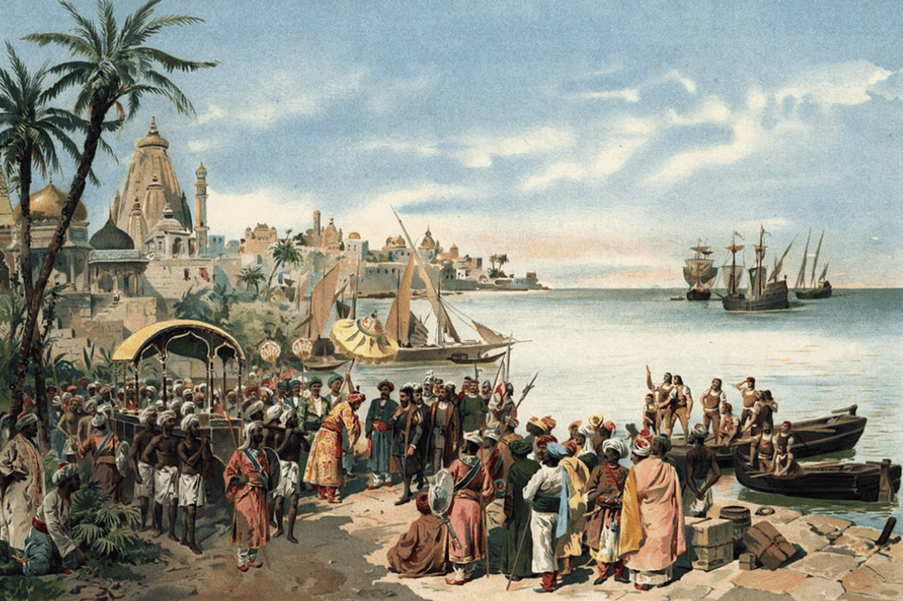
Christianity emerged in India in multiple waves, with its primeval introduction in 52 AD, with Thomas the Apostle, one of the 12 disciples of Jesus Christ, sailing to the Malabar tailspin in Kerala to preach the Gospel. Saint Pantaenus the Philosopher, the throne of the Catechetical School of Alexandria, Egypt – one of the primeval Christian schools in the world – is believed to have travelled to India in 190 AD “to preach Christ to the Brahmans and philosophers there.” Records reveal that he had found communities once practising Christianity in the region, remoter indicating that early Christians from the Middle East were once evangelising Indians during this time.

It was the inrush of the European colonial powers that introduced Western Christianity to the country. Two religious factors specified colonial rule, expressly by the Portuguese. First, the Reconquista – a series of campaigns by European Christian kingdoms to recapture territories in the Iberian Peninsula, that were occupied by Muslim kingdoms in the 8th century – had highlighted the need for greater religious unity. Second, the Europeans had heard of a legend of a priest named John in the East which indicated that a polity was practising Christianity somewhere in India. Thus, towards the end of the 15th century, Portuguese missionaries who were seeking to form anti-Islamic alliances with Christian nations reached Calicut in Kerala.
Two hundred years later, Protestant missionaries moreover started establishing Christian communities wideness the country. During this time, over 90% of Goans in the Velhas Conquistas (also known as “Old Conquests”, which refers to the places in Goa that were captured by the Portuguese towards the beginning) had wilt Catholics with the Christianisation of Goa. Bettiah Christians, widely considered the oldest Christian group in North India, moreover emerged in Champaran, Bihar in the 1700s with the king of the Bettiah Raj, Maharaja Dhurup Singh, inviting Catholic missionaries to establish the Bettiah Christian Mission. The inrush of other European powers, and the consequent establishment of Western schools, remoter spread Christianity wideness the Indian subcontinent.
India’s long history with Christianity and the variations in emergence throughout the country have tightly influenced Christmas celebrations, which are oftentimes a mixture of local and Western traditions. This “Indigenization of Christmas” can be observed in the dishes prepared for Christmas in variegated regions of the country. For instance, Christmas supplies in Delhi is usually the same dishes made during other Indian festivals, such as Gujiya, a Holi dish that is believed to be one of Lord Krishna’s favourite desserts. Other Indian sweets such as Gulab Jamun and Jalebi are moreover wontedly distributed among people for Christmas. Similarly, while Goans enjoy dishes with Portuguese origins such as sausage pulao (made of Goan sausages known as Chorizo) and sorpotel (a rich Portuguese-Goan pork stew), East Indians, an ethno-religious Christian polity in Mumbai, prepare milk creams, walnut fudge, and guava cheese for Christmas.

Another example of “Indigenization of Christmas”, is the Indian Christmas confection – an Indian version of the famous Christmas plum pudding (which dates when to medieval England). It is believed to be first prepared in India by Mambally Bapu, the founder of Mambally Royal Biscuit Factory in Thalassery, Kerala without an East India Company spice planter, Scotsman Murdoch Brown, had shared a sample of the imported Christmas plum pudding with him. Unable to find the traditional ingredients, he resorted to recreating the recipe using readily misogynist ingredients in the region, creating the Indian Christmas cake.
When it comes to religious traditions, Christian communities infringe several practices such as the Novena and the midnight mass from the Europeans. For instance, the Novena in Goa refers to nine days of devout observance and daily denomination services ending with the Christmas feast. Consoada, a traditional Portuguese Christmas Eve Meal, has moreover been unexplored by Catholic communities such as those of Goa and Mangalore. Meaning “to comfort”, the word consoada, derived from Latin, has been replaced by the word “kuswar” by these communities. Additionally, the traditional Portuguese consoada is largely made up of poached codfish, potatoes, and eggs. Indian Christians bring their own set of regional dishes.
Even in terms of decorating houses, one can observe a mix of variegated cultures. Goans use coloured rice powder and flower petals to make “kunbi” patterns on the floor. These designs often include stars, angels, and other symbols tying to Christmas. In other places, many opt to decorate mango trees, or other regional trees, instead of the traditional Christmas tree.

Christmas is a widely prestigious event wideness the North-Eastern states too. For instance, competitions are held every year in Aizawl, Mizoram to decide the best-decorated neighbourhood in the capital. These competitions vamp a lot of tourists, just like in the Cochin Carnival. Held during December-January, the safari puts up Christmas lights all over Fort Kochi. Moreover, the remnants of the Christmas and New Year celebrations of the Portuguese can be seen in the urgent of the Pappanji (an effigy of an old man) or Santa Claus on New Year’s Eve to gloat the end of the year.
The incubation of Christianity in India demonstrates version and resilience, where traditions revolving virtually the religion have well-timed to regional differences while retaining the cadre elements. This is expressly evident in the triumph of Christmas, where each region in India has a wide variety of traditions and festivities that are unique to their local contexts.
Written by- Aislin Mary Joy
Edited by- Helee Thaker
The post Christmas in India appeared first on The Economic Transcript.
